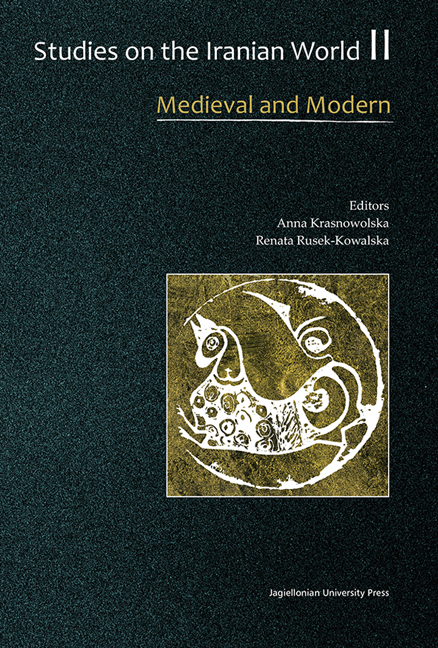Book contents
- Frontmatter
- Contents
- Foreword
- Linguistics
- Literature
- Religion
- History
- Arts
- Social and Cultural Studies
- Amulets and Medical Cures in the Yaghnob Valley: an Overview of Yaghnobi Traditional Medicine between Magic and Healing Folklore
- Persian Cookbooks, the ‘Myth’ of National Cuisine and the Process of Modernisation
- Modernity and Fertility Decline in Iran
- Medicine and Anthropology: the ‘Ambassador-Physician’ Jacob Eduard Polak (1818–1891) as a Mediator of Modernity in Iran
- Anatomy and Therapy of Eye-Diseases in Esmā῾īl Gorgānī Compared to Syriac Sources
- The Trans-Iranian Railway – History and Socio-Political Implications
- Traditional Diet and Allopathic Medicine in Diagnosis and Treatment in Iran
Amulets and Medical Cures in the Yaghnob Valley: an Overview of Yaghnobi Traditional Medicine between Magic and Healing Folklore
from Social and Cultural Studies
Published online by Cambridge University Press: 12 January 2018
- Frontmatter
- Contents
- Foreword
- Linguistics
- Literature
- Religion
- History
- Arts
- Social and Cultural Studies
- Amulets and Medical Cures in the Yaghnob Valley: an Overview of Yaghnobi Traditional Medicine between Magic and Healing Folklore
- Persian Cookbooks, the ‘Myth’ of National Cuisine and the Process of Modernisation
- Modernity and Fertility Decline in Iran
- Medicine and Anthropology: the ‘Ambassador-Physician’ Jacob Eduard Polak (1818–1891) as a Mediator of Modernity in Iran
- Anatomy and Therapy of Eye-Diseases in Esmā῾īl Gorgānī Compared to Syriac Sources
- The Trans-Iranian Railway – History and Socio-Political Implications
- Traditional Diet and Allopathic Medicine in Diagnosis and Treatment in Iran
Summary
SUMMARY
Traditional Yaghnobi medicine is based on the use of plants, amulets and magic therapy. Especially concerning childbirth, several references to apotropaic practices may be found, where the perception of natural phenomena and the imagination of the community play important roles. An attitude toward the personification of puerperal diseases is evident in the folklore of Ol, a demon represented as a tall woman with blondish hair, and in apotropaic traditions. This article is based on a comparison with the ethnomedical materials collected by Russian ethnographer E.M. Peščereva during the expeditions in the Yaghnob Valley of 1924–1927.
INTRODUCTION
This study is based on ethno-medical materials collected between 2007 and 2011 in the villages of the Yaghnob Valley (Tajikistan). The Yaghnob Valley is a small region in high mountains, along an affluent of the river Zarafšān, dif-ficult to reach. The Yaghnobs, isolated as they appeared in their homeland, have been studied for their language in the ethno-linguistic framework of the Sogdian tradition and considered as living proof of a lost culture.
After their forced displacement in 1970, as planned by the Socialist Republic of Tajikistan and the return of some 500 persons to the Valley since 1978 and especially during the recent civil war (1992–1997), the Yaghnobi community faces various different hardships that affect the state of the conservation of their language and traditions.
A report on Yaghnobi's ethno-medicine was prepared by E.M. Peščereva during the expeditions to the Yaghnob Valley of 1924–1927, directed by M.S. Andreev, when she collected ethnographical materials, tales, Yaghnobi folklore and traditions.2 At that time the Yaghnobi traditional medicine was still very much preserved. For this reason, the most interesting perspective seemed to be a comparative work with E.M. Peščereva's text in order to detect elements of continuity and compare impressions and interpretations. In this way, the study of a population which conserves the tradition of an ancient language has been the occasion to introduce myself to the medical tradition of a community which lives at high altitude, very far from hospitals and medical assistance and far from Western medical influences. On the other hand, the events involving this population in the last century could have caused a gap in the medical tradition.
- Type
- Chapter
- Information
- Studies on the Iranian WorldMedieval and Modern, pp. 291 - 304Publisher: Jagiellonian University PressPrint publication year: 2015



